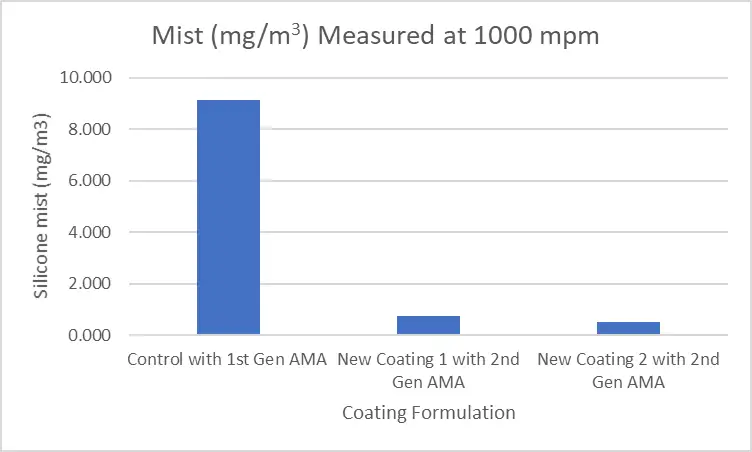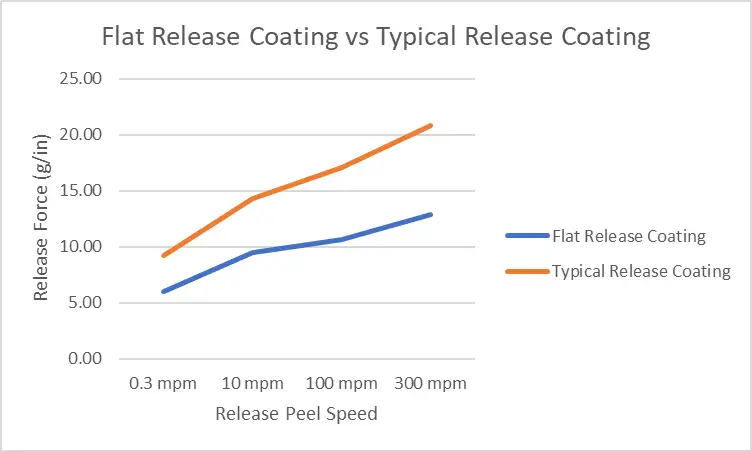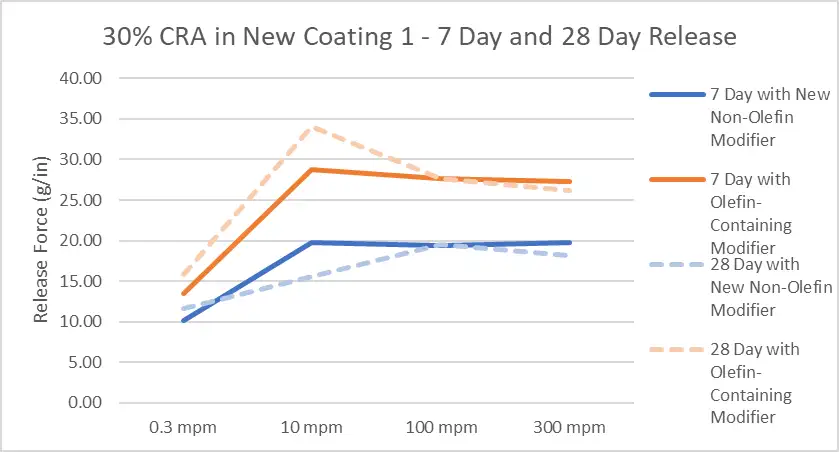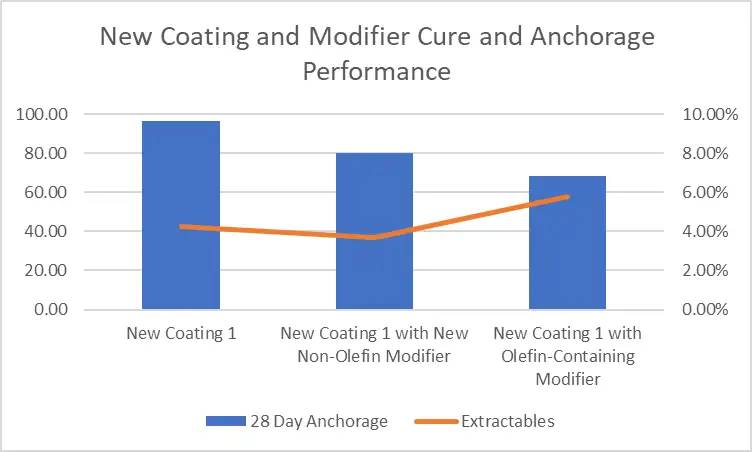
By Lori Dehlin, TS&D scientist; and Dave Rich, TS&D scientist, Dow Performance Silicones, Pressure Sensitive Industries, Dow
Silicone suppliers must continue to focus on the new trends and drivers that challenge our current technologies. There is a strong market need for higher production efficiency to improve cost and sustainability, and these advancements in coating and converting processes require silicones to evolve to address new requirements. Mist control and flat release force are the key technical performance hurdles for silicones to perform well under these more-demanding processing conditions. Silicone-release coating suppliers must create silicone-release coatings specifically for performance at high coater and converter speeds.
Introduction
Silicone-release coatings have unique low release-force properties which are used to achieve a weak interaction between the coating and a pressure-sensitive adhesive layer. In the case of label stock laminations, the silicone-release coating protects a pressure-sensitive adhesive during laminate manufacture, storage and final use. Silicones predominantly are used in pressure-sensitive laminates because of their unique properties of low migration and low release forces. Silicone-release coatings contain multiple components that determine functional attributes and performance of the finished product. The silicone is applied as a solventless (100% silicone solids) liquid in most label applications. It then is cured onto a substrate through a crosslinking chemical reaction which forms a thin, elastomeric silicone rubber.
Predicting the release performance of a label construction during high-speed operations is critical for the pressure-sensitive industry. New formulation development in the silicone-release coating space can be difficult and complex as silicone suppliers work to enhance performance. As we see coaters and converters continually increasing equipment speeds, we must adapt with these improvements. Coating suppliers must create silicone-release coatings specifically for performance at high coater and converter speeds.
What is driving technology innovation in silicone-release coatings? The only constant in our markets is change. As the markets we serve evolve, silicone suppliers must continue to focus on the new trends and drivers that challenge our current technologies. There has been a strong market need for higher production efficiency within the pressure-sensitive market over the past decade. Production efficiency focuses on optimizing throughput, allowing a shorter production time to manufacture the same product volume. This results in reduced labor and fixed cost per product unit. Additionally, the increased use of thinner substrates coupled with lower silicone coatweights lowers total cost of laminate ownership. Laminate manufacturers and their customers are looking for reduction in energy consumption, optimal use of carbon footprint in both raw materials and processes, simplified coating processes, decreased scrap waste and decreased downtime. For the label stock market, that drive toward efficiency results in higher line speeds. Current coating speeds can exceed 1,000 mpm, and line speeds will continue to increase. At the same time, the delamination converting-process speed also has become faster. Higher-speed production leads to a more sustainable and viable process.
Mist control remains a key challenge
The biggest challenge resulting from increasing coater speeds is mist control. Misting has been a longstanding industrial issue but has increased in focus as coater speeds continue to climb. Mist can lead to downtime and higher maintenance cost, among other issues. The challenge for silicone suppliers and for coater operators is to control this misting, particularly at speeds over 1,000 mpm.

Mist forms in the film split between two rolls in the coating head as a coating is transferred from one roll to another in a multi-roll configuration (see Figure 1). Formation of liquid ribs of the silicone-release coating occur in the nip across the width of these coater rolls. Filaments of silicone form under high coater speed due to high shear between the counter-rotating rolls. As the coater speed increases, shear thinning of those filaments accelerates in milliseconds. Rapid breakup at multiple points of those filaments creates aerosolized silicone mist. Mist forms for all coatings at a certain line speed; the faster the line speed, the more likely a mist is to be generated. Mist generation can be reduced significantly through use of silicone additives and optimized machine conditions.
Several challenges are posed by misting. Coaters can experience significant downtime when droplet deposition must be cleaned from equipment. Any material lost to mist is not available to coat onto the substrate. Dust accumulation in the curing oven as the web carries mist upward can reduce efficiency of heat transfer. Oven dusting also requires coater downtime for oven cleaning. These effects can cause defects, cleanliness issues, industrial hygiene concern and potential adhesive contamination in addition to downtime and material loss.

DoE yields new anti-mist additives
New tests and novel materials have been created to understand and better address the misting issue. Foundational exploration by the Dow project team began with a thorough literature search and in-depth analysis of prior work. Expertise in physics, microfluidics, spray engineering, organometallic synthesis and analytical methods was required to proceed with studies. A mist-testing machine was built to run above 1,000 mpm to more accurately model customer scenarios. Use of a DustTrak mist tester in combination with that equipment allowed quantification of mist levels (see Figure 2).
Prototypes now could be tested using a Design of Experiment (DoE) approach. The team made new advancements in modeling, prediction and testing, developing new proprietary predictive methodologies for modeling this millisecond phenomena. This rheology work resulted in a set of molecular architectures for proprietary anti-mist additive (AMA) prototypes. Those prototypes were thoroughly evaluated internally, with confirmation of results at industrial scale at equipment providers. In-depth understanding of materials science and the misting mechanism were developed – resulting in four patented families of new anti-mist additives.
Flat release force is equally important
It’s equally important to address another technical challenge imposed by high processing speeds – flat release force. Release force is the force required to separate an adhesive-backed label from its siliconized liner at a particular peel speed, and flat release force is the achievement of similar release levels at multiple peel speeds. Release force depends on a number of variables, including pressure-sensitive adhesive coatweight, rigidity of the various laminate components, peel angle and the speed at which the label/matrix is peeled away from the liner. Achieving the desired release for a particular laminate is the goal, while the rest of the requirements of the silicone-release coating are assumed.

The pressure-sensitive industry tests release forces at multiple speeds to model release behavior in various converting operations that vary from hand-peel of labels to machine labeling to matrix stripping. In high-speed machine operations, the orientation of the laminate construction can change, resulting in differences observed in release forces. There are two major ways that converters delaminate the label structure during application processing: a) peeling liner from label during processes such as bottle labeling; or b) peeling label from liner during matrix-removal steps. Generally, the former affords noticeably lower release force than the latter. Most often, laminate producers focus on testing release force at low- and high-delamination speeds. Low-speed release force relates most clearly to hand-peel applications. High-speed release tests are used to predict laminate performance in matrix stripping. Looking collectively at the release results at these different speeds gives us the release force profile (see Figure 3).
Tailored release for matrix stripping
Converting speed increases, particularly those of matrix stripping, require silicones to provide more tailored performance. Consistent release force required across all delamination speeds means a laminate will behave similarly in multiple converting processes, which can broaden application process windows. One of the most complex and problematic areas in label converting is matrix stripping, with the fastest delamination speed of laminate processing. Matrix removal is getting more challenging, as printers are reducing the size of the windowpane gap between the labels to reduce waste. Line speeds continue to increase to improve efficiency.
Release in a matrix stripping operation that is too low or “easy” can result in labels lifting with the matrix. Tight release can cause the matrix to break due to tension, which causes downtime and a sticky mess. Matrix breaks or labels lifting may slow down the machine or require expensive and tedious manual removal. Flat release in the mid- to high converting speed range is needed to minimize matrix breaks and label lifting. Release also should stay stable and consistent with time so the release force profile of a laminate immediately after manufacture is the same as the release force profile of the same laminate after aging. Stable release over time can help prevent downstream production issues. Delivering predictable and reliable performance throughout laminate shelf life is key.
The need for improved mist-control and flat-release requirements has driven significant development in silicone-release coatings. Newer silicone architectures can deliver low release force at high peel speed for a flatter release force profile, which is excellent for high-speed converting. New anti-mist additives have been created to allow high-speed coating without the drawbacks of mist generation. The polymer architecture, anti-mist additive and other components have been designed together as a system to achieve the necessary performance for evolving pressure-sensitive industry processes.
Flat release profiles fit many needs, but slightly declining release force profiles are required for some applications. A4-sized and sheeted label applications require high release force at low delamination speeds to prevent premature dispensing, while a low release force at high delamination speed is required for matrix stripping. A solventless release-coating system for bulk paper label that allows the label to release – with higher low-speed release force for improved hand-peel, and lower high-speed release force to reduce the risk of matrix breakage – is the goal for these applications. Standard silicone-release coatings often deliver rising release force profiles to varying degrees. Flat release silicone architectures can deliver the lower release force at high speeds for converting.
Benefits of non-olefin release modifiers

The label industry routinely adds release modifiers to silicone-release coatings to increase release force at low peel speed. However, the incorporation of traditional release modifiers typically also increases release force at high peel speeds. Careful selection of silicone polymer and release modifier paired together can deliver a desired release force profile (see Figure 4).
New modifier products have been created to pair with flat release polymers. With the use of these new modifiers, laminates now peel easier at the higher converting speeds, therefore reducing the chance of web breaks in matrix stripping. This translates to improved productivity in label converting and dispensing operations. Newer release modifiers also are solventless in recognition of sustainability concerns. The labeling industry historically has used olefin-containing release modifiers to boost release force at low peel speed. Olefin, typically tetradecene or octadecene, is a volatile organic component. The newer release modifiers without olefin cure at very fast siliconizing speeds and allow reduced platinum (Pt) levels to be used in the bath formulation. The new non-olefin modifiers deliver the required release at low silicone coatweights without significant mist generation. This new technology can help decrease waste and downtime.
Doing multiple things well at the same time
A complex baseline of expectations for silicone-release coating performance must be met for these label applications, with specific performance criteria driven by higher line speeds. The variety of requirements placed upon silicone-release coatings often is underestimated in the pressure-sensitive label industry. Multiple key technical challenges must be considered in any development, as silicone must do many things well simultaneously to meet processing and performance needs. The silicone formulation must allow effective mixing of components. The silicone bath must promote good coatability, with controlled viscosity and adequate wet-out on a variety of substrates. Sufficient bath life at room temperature for bath and coater preparation and coating application is critical. The formulated silicone-release coating must maintain fast and complete cure, without sacrificing solid anchorage to the substrate. The silicone components need to allow formulation flexibility and enable low catalyst use at any speed.

Additional requirements on silicone-release coating performance come with increased coater line speeds. The homogeneity of coating coverage and thickness are more critical at high speed, as there is less time for coating to wet-out on the substrate. Faster polymer miscibility is required, particularly for in-line mixing. As the shear level of equipment increases with line speed, the rheology of the silicone-release coating formulation must be considered. Faster and more complete curing to avoid silicone migration is required. Good anchorage performance achieved with robust adhesion of cured coating to the liner substrate is important for converting performance. Sufficient anchorage of the silicone to the liner avoids delamination, silicone migration and cross-contamination over the lifetime of the pressure-sensitive label (see Figure 5).
Conclusion
Silicone-release coating technology continues to evolve to address tomorrow’s challenges presented by advancements in coating and converting processes. Higher-speed production leads to a more sustainable and viable process with many benefits while creating new technical hurdles for silicone-release coatings. Silicone suppliers need to innovate for not just label-stock converters but for label printer/converters, and labeling end-users as well, for years to come.
The key to that evolutionary process for high-speed coating was fundamental research using rigorous scientific methodology and an in-depth understanding of materials science, which created foundational knowledge of the misting mechanism that results from high silicone-coater speeds. Development of new patented anti-misting, release-coating technology capable of solving the long-standing industrial misting issue was one outcome.
Addressing the need for flat release performance, and declining release for A4 and sheeted products, with a focus on high-speed matrix stripping, was the other. Polymer architecture and release-modifier products have been developed specifically to deliver required release-force profiles. Silicone coatings delivering consistent flat release profile through all converting speeds with stability over time have been created. A modifier delivering easier high-speed release while increasing low-speed release complements the creation of these coatings.
Silicone often is the last component of a laminate to be chosen, and it typically must fit into a narrow performance window. By understanding key trends and drivers and incorporating foundational science into development efforts, silicone suppliers are positioning themselves to innovate with customers as they evolve and grow.

Lori Dehlin, technical service and development scientist, Dow Performance Silicones, Pressure Sensitive Industries for Dow (Midland, MI), holds a Bachelor of Science in Chemical Engineering from Michigan Technological University. Prior to joining Dow Corning/Dow, she worked for six years at a major international paper company, holding several technical and customer-facing roles. Lori started at Dow Corning in 2005 as an engineer in Process Engineering, supporting organofunctional silanes technology. She transitioned to the AETS role in Packaging in 2007, moving to Dow TS&D in the same market with the acquisition of Dow Corning. Lori is responsible for technical support, application engineering and development for Dow customers in North America, providing innovative silicone technology solutions. She can be reached at 989-496-1558, email: lori.dehlin@dow.com, www.dow.com/en-us/product-technology/pt-release-coating-systems.html.

Dave Rich, senior technical service and development scientist for Dow, earned a BSC degree in Chemistry from Nottingham Trent University. He started at Dow Corning in 1986 as a technician supporting Oil & Gas and cookware/bakeware coatings. He transitioned to the Product Development role in Packaging in 1995, moving to Dow TS&D in the same market with the acquisition of Dow in 2017. He can be reached at 989-496-6806, email: david.rich@dow.com.

